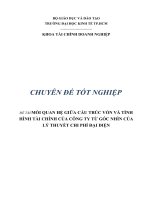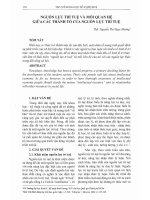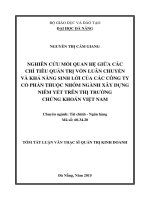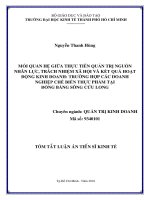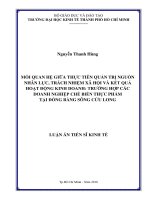Mối quan hệ giữa các nguồn lực bên ngoài, nguồn lực điểm đến MICE và sự phát triển du lịch MICE trường hợp nghiên cứu tại đà lạt tt tiếng anh
Bạn đang xem bản rút gọn của tài liệu. Xem và tải ngay bản đầy đủ của tài liệu tại đây (463.72 KB, 31 trang )
1
MINISTRY OF EDUCATION AND TRAINING
UNIVERSITY OF ECONOMICS HO CHI MINH CITY
--------------
LE THAI SON
RELATIONSHIP BETWEEN EXTERNAL
RESOURCES, MICE DESTINATION
RESOURCES AND MICE TOURISM
DEVELOPMENT – CASE STUDY IN
DALAT CITY
Major : Business Administrative
Code : 9340101
SUMMARY OF ECONOMIC DOCTORAL THESIS
Ho Chi Minh City - 2019
2
The work was completed at:
University of Economic, Ho Chi Minh City
The scientific intructors:
Assoc. Prof. Hà Nam Khánh Giao
PhD. Đinh Công Khải
Reviewers 1:..................................................................
......................................................................................
Reviewers 2:..................................................................
......................................................................................
Reviewers 3:..................................................................
......................................................................................
The dissertation will be defended in front of the
Dissertation Evaluation Council of University
of Economic of Ho Chi Minh city at ............................
2019
The dissertation can also be found at:
- National Library of Viet Nam
- General Scientific Library of Ho Chi Minh city
- Library of University of Economic, Ho Chi Minh city
1
CHAPTER 1. RESEARCH OVERVIEW
1.1 Research necessity
MICE
tourism
(Meeting,
Incentive,
Conference,
Exhibition) is an area in the tourism industry, and is a highly
productive and efficient service sector of the tourism industry,
being seen as a driving force to promote local and national
economic development. (Dwyer and Forsyth, 2008)
This thesis focuses on studying destination resources, the
research on tourism development to create development, but
does not mention the direction of destination image research.
Resource theory was studied by many researchers (Haugland et
al., 2011; Denicolai et al., 2010; Rusko et al., 2013). Studies
have shown that a destination, relying on resources, can build
and develop MICE tourism. However, not much research
focused on which resources that affect MICE tourism
development at a destination.
Through the review of previous studies:
Most studies in the direction of destination resources
research conclude that destinations need resources to develop
tourism, but does not indicate what kind of resources. Haugland
et al., (2011) emphasized the capability, cooperation and
network relationship between destinations; Denicolai et al.,
(2010) emphasized on the core competencies of tourism, the
correlationship between stakeholders to influence. Ramgulam et
al.,
(2012)
also
emphasized
the
relationship
between
stakeholders involved in MICE tourism activities. Some of the
other studies also underlined the resources of stakeholders to
support tourism development at destinations.
2
Research on MICE tourism development often pays
attention to the impacts of the economy, culture, society,
environment... but does not do the same to the resources that the
destination can rely on it to develop. In order to have an
obvious view on the resource-based theory to develop, this
thesis will synthesize previous studies, build a theoretical theory
and be verified by quantitative study in Dalat.
Developing MICE tourism in Dalat is one of the
important
strategic
orientations
in
the
socio-economic
development of the locality and towards sustainable tourism
development. Therefore, studying the relationship between
external resources and the resources of MICE destination
affecting the development of MICE tourism in Da Lat is very
necessary.
1.2 Research objectives
1.2.1 Research objectives
The specific research objectives of the thesis are:
-
Building the model of exteral relationship between external
resources of suppliers, organizers, professional organizations,
MICE tourists, resources of MICE destination and MICE
tourism development at Dalat MICE destination.
-
Testing the compatibility between the theory and data of the
research model at Dalat MICE destination.
-
Proposing
governance
implications
for
participating
businesses that provide resources, along with resources of
MICE destinations, to create MICE tourism development in the
future.
1.2.2 Research questions
3
- How are the resources of suppliers, organizers, professional
organizations, MICE visitors and MICE destination resources
related to each other and are they associated with MICE tourism
development?
- About applications when studying at Da Lat destination, how
external resources of suppliers, organizers, professional
organizations, MICE tourists are affecting to MICE destination
and which extent does it affect the development of MICE
tourism?
- What are the managerial implications for tourism businesses
so that they can provide the most reasonable and effective
resources to both developing tourism and benefiting businesses?
1.3 Object and scope of the research
The survey objects in qualitative research are leaders,
administrators,
business
professionals
representing
organizations related to MICE activities in Da Lat, specialized
lecturers in some University.
The survey objects in quantitative research are 135
domestic and foreign tourism enterprises, providing MICE
tourism services, based in Ho Chi Minh City and Southeast
provinces. A leader, an administrator and one to two sales
professionals of each unit will be interviewed by an interviewer
1.4 Research Method
Mixed research method includes two phases: qualitative
research and preliminary quantitative testing in the first step,
quantitative research to test the model in the next step.
Secondary data is used to determine the selection criteria for
Dalat MICE destination
4
1.5 New contributions of the thesis
(1)
Modeling
a
relationship
between
external
stakeholders' resources and MICE destination resources to
influence MICE tourism development at a destination.
Concretizing
destination
resources
research
resources,
of
MICE
concepts:
MICE
tourists,
MICE
tourism
tourism
stakeholders
MICE
development
by
and
business
management scales.
(2) Measuring the impact of external resources, MICE
destination resources to affect MICE tourism development.
1.7 Thesis structure
The thesis consists of five chapters: the first one presents
research overview; the second one describes theoretical basis
and research model; the third one presents research design; the
fourth one performs result findings; the fifth one present
conclusion and implifications.
5
CHAPTER 2. THEORETICAL BASIS AND RESEARCH
MODEL
2.1 The theoretical basis of MICE tourism
2.1.1 MICE concept - MICE tourism
MICE is an acronym for Meeting, Incentive, Conference,
and Exhibition. From different research approaches, the name
chosen depends on the type of event studied (Rogers, 2003),
and partially depends on geographic location. According to
Worlds Tourism Organization (2006), the conference industry
consists of the main components: (1) Meeting and Conference;
(2) exhibitions, and (3) promotions.
MICE tourism requires a variety of activities at different
levels for many stakeholders (Mistilis and Dwyer, 2008), that
means activities related to supply-demand components for
transporting tourists, places for accomodation, places for
sightseeing, shopping and entertainment.
2.1.2 Components of MICE tourism
* Meeting
Meeting is a term that refers to the gathering of some
people in one place to exchange or perform a specific activity
with different reasons (Getz, 2008). According to Fenich
(2005), the most important reason for the meeting is to solve
problems and make conclusions.
* Incentive
The Incentive is a travel trip that is fully paid by the
organizer (Rogers, 2003) to encourage and reward workers
(Fenich, 2005; Rogers, 2003). It can include many elements of a
trip such as education, group activity, research, and discovery.
6
* Convention, Congress, Conference
The conference usually involves a large meeting for
general purpose, held every year. Therefore, it needs a wellprepared plan with the goal of business and broad social issues.
Congress is often related to large national and international
meetings and the Conference is an event organized by any
organization to meet, exchange, give opinions to a question
specific topics.
* Exhibition
The exhibition aims to introduce new products, often
integrated into the audience by attendees, and it is part of the
seminar. Fenich (2005) argues that an exhibition is an event
where the main activity is the attendee to see the new products
on display. This event focuses mainly on business orientation,
especially to increase new customers.
2.1.3 Features of MICE tourism
* Three highs: high growth potential, high added values, and
highly beneficial innovations.
* Three larges: large output, large opportunities for employment
and large industry associations.
* Three advantages: more advantage than other industries on
the efficient utilization of human resources, technological
know-how, and efficient utilization of assets. (Janakiraman,
2012).
2.1.4 MICE Tourists - MICE Destination
MICE tourists are employees or individuals participating
in MICE activities in the country and abroad (Cook, Yale,
Marqua, 2006; Swarbrooke and Horner, 2001; Chao, 2010).
7
MICE visitors is one kind of tourists, but tourist motives are
somewhat different from ordinary travelers in MICE travelers
who aim to focus on seeking knowledge or value or creating
habits rather than sightseeing tours.
MICE destination: According to Getz (2007), a destination can
be called a MICE destination when there are seven essential
elements: (i) Infrastructure, (ii) Housing, (iii) Transportation,
(iv) Attractions, (v) Service, (vi) Retailers, (vii) Places and
recreational facilities. Chiu and Ananzeh (2012) argue that a
MICE
destination
has
6A:
Amenities,
Accessibility,
Accountability, Affordable, Attractions, and Activities. Thus,
MICE destination is a geographic region with its own
comparative and advantage resources, unique features that
make it attractive, deversity in infrastructure and services, high
quality, and integrating resources from within and outside the
destination to provide high-quality MICE tourism products.
2.2 Theory of stakeholders involved in MICE tourism
2.2.1 Concept and theory of stakeholders
According to Harrison and Freeman (1999), stakeholders
are any group of individuals that may or may be affected by
achieving the organization's goals. Clarkson (1995) suggests
that stakeholders are groups of people or individuals who have
the right to complain, to own, other rights or benefit in a
company or its activities in the past, at present or future. In fact,
the focus of this concept should be considered in relation to the
events, that means in different events, stakeholders may have
changes in participants and roles. The role of stakeholders
depends on how well the capability of the stakeholder's impacts
8
or meets the needs of the organization (Jawahar & Mclaughlin,
2001).
Michell et al,. (1997, p.873) states that “Stakeholders will
obviously be closely related to the accumulation of the number
of stakeholders' characteristics: authority; legitimacy and
urgency that managers must be aware of”. This theory is
described by Venn diagram, consisting of three sets, each
representing one of the three characteristics. All groups or
individuals gain relevant prominence based on the number of
features accumulated. The higher the number of features, the
more prominent the group or individual is. Stakeholders only
possess
one
characteristic
called
latent
stakeholders.
Stakeholders take two characteristics that can called expectant
stakeholders and three characteristics that are called highly
salient stakeholders.
The thesis used Michell et al., (1997) theoretical framework
as a basis for experts to consider and select stakeholders in
terms of authority, legitimacy, and urgency. Stakeholder who
has all the three characteristics are called highly salient
stakeholders and are considered as external resources that
impacts the destination.
2.2.2 Classification of stakeholders
Reid and Arcodia (2002) have divided stakeholders into
two types: key stakeholders and secondary stakeholders.
According to Hardy and Beeton (2001), stakeholders is
classified into four general groups: residents, operators, visitors,
and managers; Getz et al., (2007) have more specific
classification of stakeholders including (i) Equipment supply:
9
support and provision of resources for the event; (ii) Moderator:
usually a regional or central government; (iii) Co-producer:
individuals and organizations participating in the event; (iv)
Allies and cooperation: professional organizations, travel
agencies; (v) Affected people: audience and community; The
consultants of the WTO have developed a stakeholder
conceptual framework of a tourism destination including
destinations, visitors, governance organizations, communities,
and local authorities. Stakeholders studied in this thesis will be
synthesized from stakeholders that often used in the above
studies and voted by experts according to the research
conditions of Dalat - Vietnam.
2.3 Resource-based theory
2.3.1 Resource concept
The resources of an enterprise include the structure of
assets, organizational
information,
processes,
knowledge...
business
controlled
by
characteristics,
enterprises
to
implement strategic activities to achieve efficiency and
performance (Barney, 1991). Barney and Arikan (2005) classify
resources to study into three groups: physical resources, human
resources, and organizational resources. Rindova and Fombrun
(1999) consider knowledge, values, beliefs, and intangible
values to be a source of research. In general, an organization
can have three types of resources (1) tangible and intangible
resources; (2) knowledge resources and (3) relationship
network.
2.3.2 Resource-based theory
10
The basic resource-based theory include a Resourcebased view; Knowledge based view and Relational view.
Resource-Based View - When studying RBT at Brazilian
tourist destination Nakatani and Teixeira (2009) find that
destination resources can be interpreted as a combination of
some current resources and some rare resources for production,
service provision, obtaining and maintaining results in longterm. Therefore, relying on resources is one of the ways to
reduce the cost of copying or acquiring resources that other
organizations are managing and not easily transferred without a
strategic alliance or cooperation.
Knowledge-Based View - The knowledge that is in the
organization, regardless its spillover effect on all sections, can
be classified as organizational-based knowledge. It stimulates
change and innovation in organizations (Venkitachalam and
Busch, 2012). The knowledge acquired in the destination and
region includes not only the knowledge handled by the
organizations in it (eg people, communities and private business
organizations) but also affect efficiency of regional networks in
creating innovation and dealing with issues of changing the
business environment of destinations and regions. From the
perspective of governance, Cooper (2006) argues that the
knowledge resources need to capture and encode knowledge,
create a flow to transfer knowledge.
Relational View - Weiland and Wallenburg (2012) argue that
relationship resources can affect members of the system and can
increase operational efficiency. The ability of relationships can
be based on information, cooperation, and mutual integration.
11
When stakeholders create relationships through specific
transactions, the special resources that they pay attention to are
usually (1) special locations related to production and service
points are close to each other; (2) physical assets related to
special machines, and types of equipment, and (3) is a special
asset: human being related to a specific understanding
accumulated by traders through long-term relationships,
developing experiences working together and accumulating
specialized and linguistic information , and understanding (Dyer
and Singh, 1998).
2.4 Theory of MICE tourism development
2.4.1 Development concept
The United Nations Development Program (2013) points
out that development by providing more options, more freedom
for the people and they have the opportunity to participate in
meaningful activities is right way. From this concept, applied in
the field of tourism, tourism development will provide many
types of tourism, many packages of products and services for
tourists and participate directly in tourism activities that tourist
guests selected.
2.4.2 Theory of MICE tourism development
Đinović (2010), Fan (2017) found that MICE tourism
development is: (i) the increasing profits for local businesses
through the amount of money spent by visitors for food
expenditure, shopping, entertainment ...; (ii) Through revenue,
MICE tourism has contributed directly and indirectly to the
government budget; (iii) creating more jobs for the company as
a service provider or agent; (iv) stimulate investment in both the
12
public and private sectors in tourism and entertainment
infrastructure to meet the increasing demands of visitors on
service quality; (v) maintaining the quality of the environment.
MICE tourism development means the increase of
tangible and intangible natural resources both in quality and
quantity; the increase of organizational experience, effective
connection network and resource protection for the future. In
other words, the resources affecting the destination will be
focused to allocate, effectively utilize in the long term to sustain
development.
2.4.3 Characteristics of MICE tourism development
- Contributing more revenue to GDP;
- There are more International Exhibition and Convention
Centers, luxury hotels and resorts in MICE destinations;
- Steadily increasing domestic and foreign tourists over years;
- Developing a network of relationships between stakeholders;
- Exchanging and developing cultural features between tourists
and residents.
2.4.4 The impact of MICE tourism development
(i) Bringing greater profits to stakeholders; (2) Reinvesting in
the future for destinations; (3) Preserving resources.
2.5 Resource factors - MICE Destination resources
Based on Michell et al., (1997) theory, stakeholders
meet all three criteria of authority, legitimacy, and urgency
compiled from foreign studies, and voted by experts. As a
result, stakeholders were selected according to the resource
direction when studying in Dalat were: Suppliers; Organizers;
13
Professional
organization;
MICE
tourists
and
MICE
Destinations.
At a destination, the supplier will consider investing
resources in long-term activities such as investment in hotels,
luxury resorts, exhibition centers..., or appropriate infrastructure
with tourism activities to ensure its operations. By network
connection, they also associate with other service providers in
the MICE tourism supply chain such as transportation,
equipment for event organization, advertising activities, sale
souvenir ... (Tingting et al., 2007). Working as a service
provider for events, suppliers also use their experience
resources in the field of service providers such as processes,
systems of procedures, knowledge of experts, employee's skills
to ensure successful organization of event at the destination.
Organizer resources: Organizers can be government,
local government, associations, or businesses, so applying the
resources concept is convenient. The resources of other
organizers are different in scale, quantity, and composition.
When organizing an event they all have to rely on their own
resources, often their physical, human resources, knowledge,
experience and organizational prestige. In addition, they must
use their network relationships to call other service providers
and stakeholders (Tingting et al., 2007). Through the
relationship network, all resources of each stakeholder currently
have, will be incorporated into the event organization. Residents
or volunteers also play an important role in attracting MICE
Tourists to the event (Simpson, 2004).
14
Professional organization resources: The most important
resource of a professional organization is the experience
through practical activities and extensive relationships. They
often approach both supply and demand to bridge the host of
events, attract potential suppliers (Davidson, 2007). In the
demand direction, they regularly study, update behavior,
awareness, attitudes, and needs of visitors; explore potential
tourist groups, promote tourism to attract them to the event.
MICE tourists resources: Saayman and Saayman (2006),
Yoo and Lee (2014) show that MICE tourists use their
resources to make two important contributions to the
destination: (1) spending at the destination when they
participate in tourism activities, and (2) promoting the
environment creation for visitors to increase their travel
spending. Prebensen et al., (2013) point out that MICE tourists'
important resources are their experience gained when they
participate in tourism activities. With their resources, MICE
tourists will contribute to MICE destinations more efficiently.
The resources of a destination at a time include the
structure of tangible assets such as natural resources; intangible
assets such as cultural assets, capabilities, information, high
skilled human resources available at the destination, combined
with other external resources contribute to that stakeholder
activity at the destination (Seebaluck et al., 2013; Mistilis and
Dwyer, 2008).
2.6 Theory model
Based on the theories presented in Sections 2.2, 2.3, 2.4,
2.5, and discussions about the relationship between external
15
resources and MICE destination resource affecting MICE
tourism development, and proposed hypotheses:
H1: Supplier resources have a positive (+) relationship to MICE
destination resources.
Supplier resources
(S)
Organization
resources (O)
Professional
organization resources
(A)
H1
+
+
H2
MICE destination
+
H3
resources (D)
H5
+
MICE tourism
development
(PT)
+
H4
MICE tourist
resources (T)
Figure 2.1 Theoretical model
H2: Organization resources have a positive (+) relationship to
MICE destination resources.
H3: Professional organization resources have a positive (+)
relationship to MICE destination resources.
H4: MICE tourist resources have a positive (+) relationship to
MICE destination resources.
H5: MICE destination resources have a positive (+) relationship
to MICE tourism development.
2.7 Competition model
Nguyen Dinh Tho and Nguyen Thi Mai Trang (2008)
argue that instead of focusing only on a theoretical model, we
need to test it with the competitive model. In addition, the
16
method of linear structural analysis allows to study many
possible relationships between factors in the model and the
same model. Therefore, this study proposes three competitive
models to compare with the theoretical model to choose the best
model.
Competitive model 1: The relationship between MICE
tourist resources and MICE tourism development - MICE
tourists are co-creators of value, experience in an event related
to interacting with other visitors, service staff, residents...
(Prebensen et al., 2013). On the consumption side, MICE
tourists are the people who promote the development of
services and goods to stimulate them for more consumption of
different products and services, and as a result, the increasing
value for themselves and other stakeholders (Dwyer et al.,
2003). Hussain and et al., (2014) found that MICE tourists
travel to Malaysia stimulated MICE tourism development.
From the above discussions, the author proposes a hypothesis:
H6: MICE tourists resources have a positive relationship
(+) to MICE tourism development.
Competitive model 2: The relationship between
supplier resources and MICE tourism development Research by Haugland et al., (2011), Ramgulam et al., (2012)
showed that the resources of suppliers and resources derived
from network relationships between destination and service
providers are factors affecting MICE tourism development.
Anitha and Chandrashekara (2018) determine Karnataka's
opportunity to develop tourism is to have a variety of products
17
provided by many external suppliers and destination suppliers.
Therefore, the author proposed hypothesis H7:
H7: Supplier resources have a positive relationship (+) to
MICE tourism development.
Competitive model 3: The relationship between
supplier resources, MICE tourist resources, and MICE
tourism development - From the arguments in the competitive
model 1 and 2, the author proposes a competitive model 3,
which impact both supplier resources and the resources of
MICE visitors on MICE tourism development.
18
CHAPTER 3. RESEARCH DESIGN
3.1 Research process
Phase one
Identify stakeholders
Research
objectives
Experts opinion
Research
documents
Qualitative research
Preliminary questionnaire
Experts opinion
Phase two
Preliminary
quantitative
research N=100
Evaluating reliability
EFA analysis
Official questionnaire
Phase 3
Official
quantitative
research N=400
Reassign the EFA
EFA analysis
CFA analysis
SEM model
Discussion
Figure 3.Research process
Experts opinion
19
3.2 Research scale
The scales used in this thesis are synthesized, inherited
from previous studies. Specifically, Supplier Resources Scale
based on studies of Lai and Vinh (2013), Rittichainuwat and
Beck (2001), Chao (2010); Organization Resources Scale was
based on studies of Tingting et al., (2007), Simpson (2004),
Dwyer et al., (2000), and Whitford (2009); Professional
organizational resources Scale based on Angella's research
(2007); MICE tourist resources scale based on studies by
Saayman and Saayman (2006), Yu and Lee (2014); MICE
Destination resources Scale based on studies by Whitfield et al.,
(2014), and MICE tourism development scale based on studies
by Rósbjörg (2010), Sangpikul and Kim (2009), Đinoví (2010),
Ramgulam et al., (2012), Yoon et al., (2001), Chao (2010),
Whitford (2009), Sylla et al., (2013). These scales are adjusted
by expert method to meet the research conditions.
3.3 Preliminary assess the scale
3.3.1 Testing prelimination scale by analysing Cronbach’s
Alpha reliability
Reliability analysis results show that all of the variables are
reliable with Cronbach's Alpha coefficients greater than 0.7; the
total correlation of all variables are satisfactory (>0.4).
3.3.2 Testing scale results by exploring factory analysis
The results of EFA analysis of external resources, MICE
destination resources, and MICE tourism development using the
Principal Axis Factoring method with Promax rotation have
both factor loading and total variance extracted, the variables
are grouped initially, without variable movement.
3.4 Methods of data analysis in official research
20
CHAPTER 4. RESEARCH RESULTS AND DISCUSSION
4.1 Official research
The quantitative study was officially conducted in the
provinces and cities of the Southeast Viet Nam. There are
285/400 questionnaires used for analysis and verification.
4.2 Results of retesting of the exploratory factor analysis
Conduct EFA analysis for external resource factors,
resulting in coefficients KMO = 0.853 and Sig = .000; total
variance extracted 59,150%. The results show that the observed
variables are grouped into the initial factors as expected.
4.3 Confirmatory factor analysis (CFA)
4.3.1 CFA results from external resources scale
At the second CFA analysis, the results showed that the
model had 51 degrees of freedom, Chi-square = 172,775 (p =
0,000); CMIN / df = 1,529 is smaller than 2. Other indicators
show that the model is suitable for market data, namely: GFI,
CFI, TLI are 0.937; 0.960; and 0.952 and RSMEA = 0.043 less
than 0.06. This measurement model is consistent with market
data, achieving unidirectionality, discriminating values and
convergence values.
4.3.2 CFA results from unidirectional scales
Conducting CFA analysis, the model has 52 degrees of
freedom, Chi-square = 111.951 (P = 0,000), CMIN / df = 2,153
is smaller than 3. The GFI, CFI and TLI indicators are 0,935;
0.957; 0.945 (> 0.9), and RSMEA = 0.064; It can be seen that
the model responds to market data, achieving uni-directional,
discriminatory, convergent values achieving unidirectionality,
discriminating values and convergence values.
21
4.3.3 CFA results of the saturate model
Figure 4.1. CFA results of the saturate model
(Source: Results from data collection)
The CFA result of the saturate model (Figure 4.1) has Chisquare = 435.957 with P = 0,000; GFI = 0.891; TLI = 0,919;
CFI = 0,929; RMSEA = 0.053 less than 0.06. The above
indicators confirm that the model fits well with market data.
As convergence values, standardized regression weights are
statistically significant; for discriminal values, the correlation
coefficient between concepts is less than 1 and statistically
significant. CFA results are summarized in Table 4.2.
22
Table 4.1 Results of distinction values of saturate Model
Correlation
r
SE
CR
P value
D
<--> S
0,623 0,045
8,431
0,0000
D
<--> O
0,571 0,047
9,141
0,0000
S
<--> O
0,542 0,048
9,533
0,0000
O
<--> T
0,538 0,048
9,587
0,0000
D
<--> T
0,553 0,048
9,385
0,0000
S
<--> T
0,530 0,048
9,695
0,0000
D
<--> PT
0,402 0,052 11,425
0,0000
S
<--> PT
0,361 0,053 11,986
0,0000
O
<--> PT
0,459 0,051 10,652
0,0000
T
<--> PT
0,449 0,051 10,787
0,0000
(Source: Results from data collection)
Table 4.12 the test results all of the scale of the model
Co
de
Numb
er of
varia
bles
S
O
MICE traveler
resource
Scale
Reliability
ρvc
λ
4
4
α
0,838
0,717
ρc
0,851
0,724
0,593
0,397
0,763
0,629
T
4
0,771
0,776
0,604
0,777
MICE destination
D
7
0,828
0,837
0,426
0,649
MICE tourism
development
PT
5
0,880
0,88
0,595
0,771
Supplier resource
Organizer resource
(Source: Results from data collection)
4.4. Testing of research models
4.4.1 Testing of the official theory model
The model has 245 degrees of freedom, Chi-square
= 459.198 (p = 0.000), Chi-square / df = 1,874 is smaller
than 2; GFI = 0.886; TLI = 0,912; CFI = 0.922, and
RMSEA = 0.055 less than 0.06. This indicates that the
model fits the market data.
Val
ues
Fit
23
(Source: Results from data collection)
Figure 4.2 SEM results of the theoretical model (Standardized)
Table 4.3 Standardized regression coefficients of the theoretical model
Correlation
Estimate
S.E.
C.R.
P-value
S
→
D
0,364
0,053 11,984
0,0000
O
→
D
0,268
0,055 13,334
0,0000
T
→
D
0,234
0,055 13,827
0,0000
D
→
PT
0,442
0,051 10,917
0,0000
(Source: Results from data collection)
4.4.2 Testing of the competitive model
To assess the test result objectively, the thesis stated the
bases for proposing to test 3 competitive models to select the
best competitive model to compare with the proposed
theoretical model. As a result, in the three competing models,

